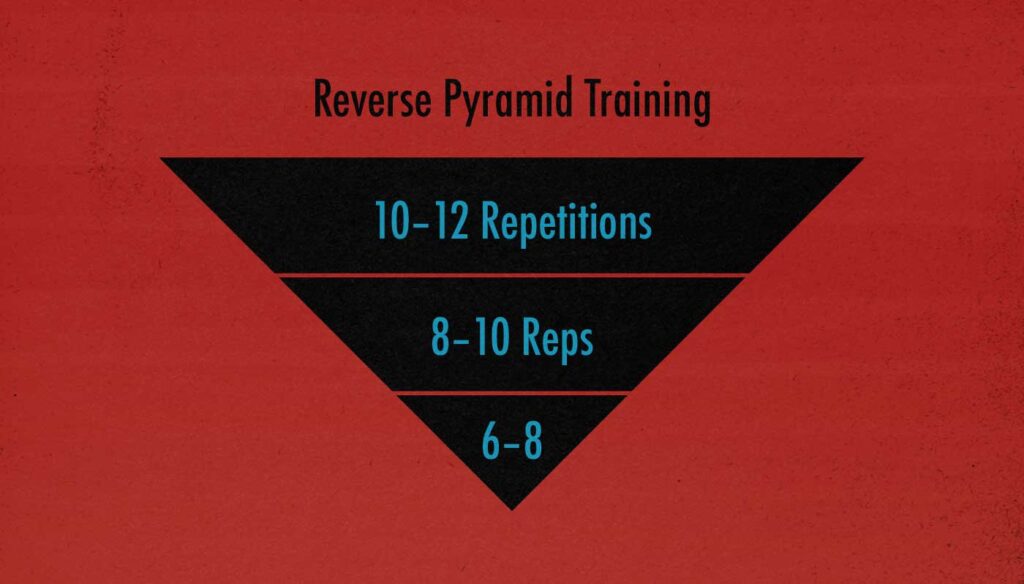
Reverse Pyramid Training Guide
Reverse Pyramid Training is a popular way for intermediates to break through muscle and strength plateaus. It’s also quite efficient, typically involving three full-body workouts per week, each lasting less than an hour.
In this article, we’ll discuss the pros and cons of Reverse Pyramid Training, why you might want to train this way, how to do it, and then give a sample workout program. We’ll also cover whether it’s a good way of stimulating muscle growth compared to other training methods, such as traditional hypertrophy training.
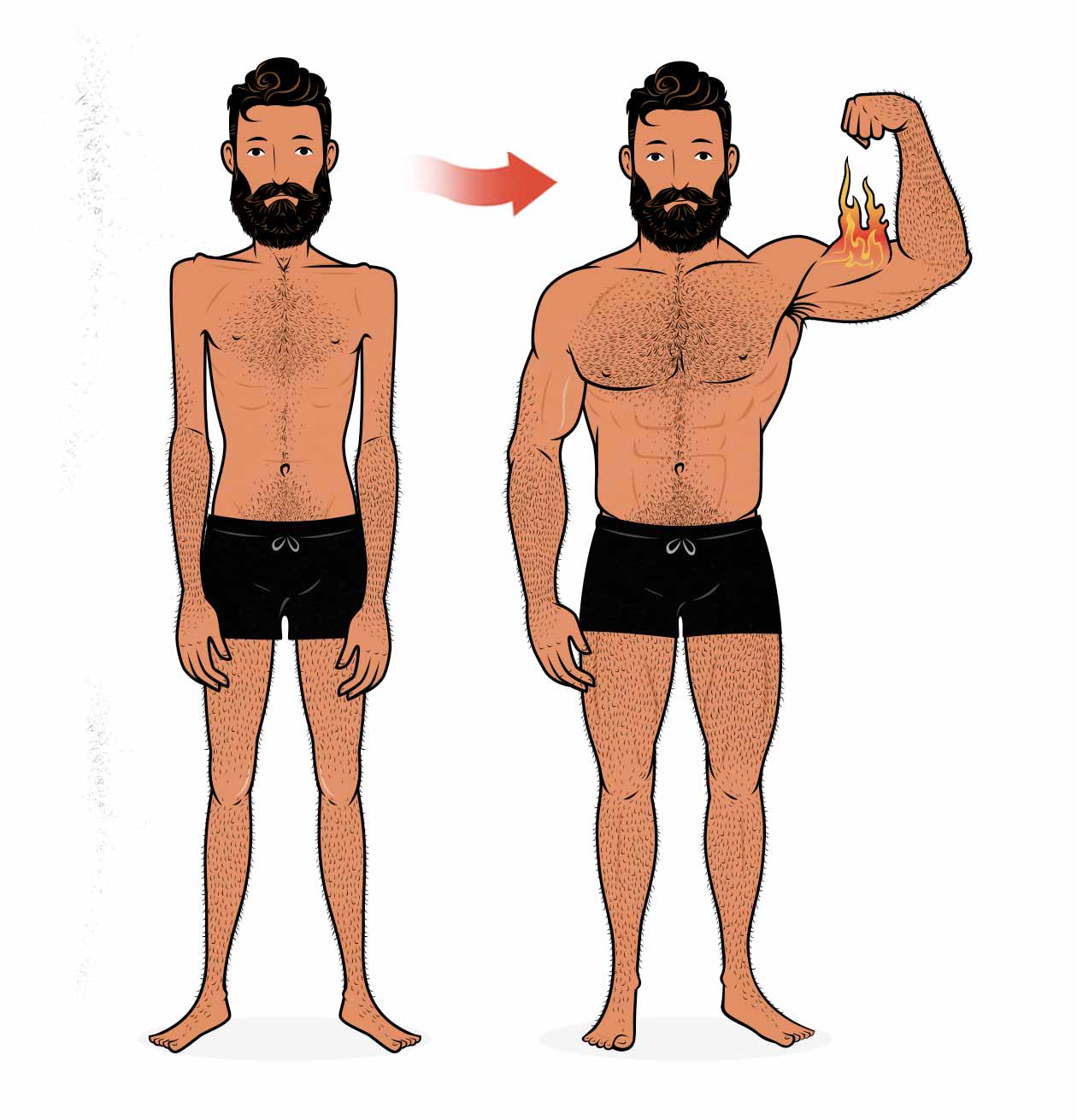
What is Reverse Pyramid Training?
Pyramid training, often called “crescent training” in the research, is when we combine both heavier and lighter sets for our main exercises. Instead of using the same weight every set, we add or remove weight from the bar.
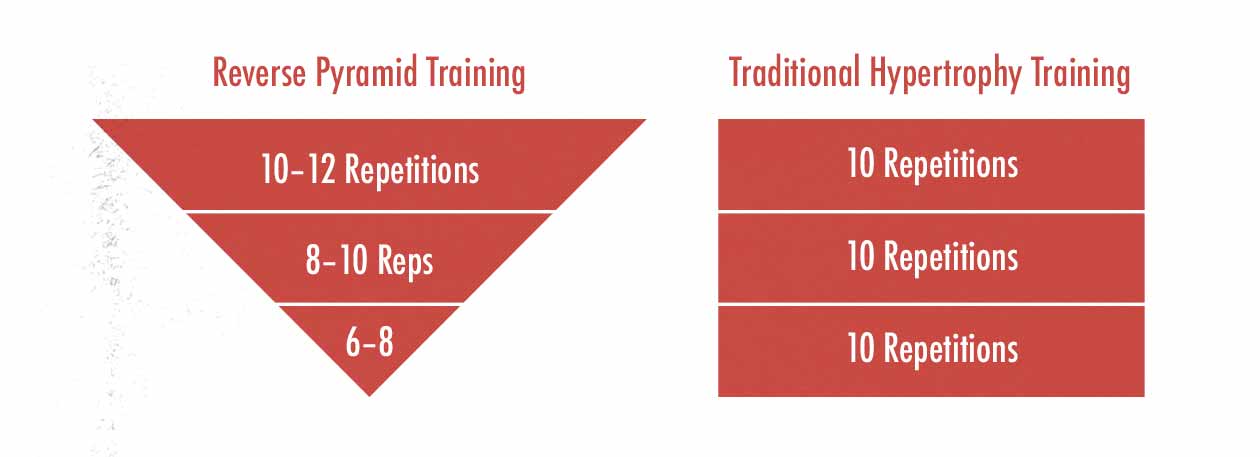
There are two types of pyramid training: ascending and descending.
- With ascending pyramid training, we add weight to every set. For instance, we might do a set of 12 reps, add weight, rest, and do a set of 10 reps, add more weight, rest, and then do a set of 8 reps.
- With descending “reverse” pyramid training, we remove weight from every set. For instance, we might do a set of 8 reps, remove weight, rest, and do a set of 10 reps, remove more weight, rest, and then do a set of 12 reps.
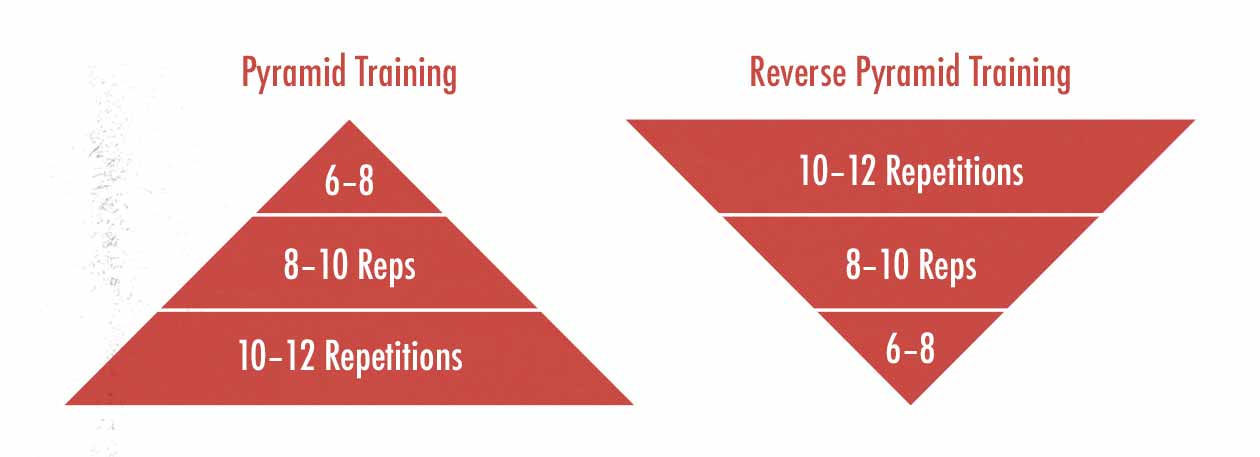
Reverse Pyramid Training is the more popular of the two approaches, and with good reason. We gain 1-rep strength more easily from doing heavy sets while fresh, whereas we gain muscle size just as easily when training with some fatigue. As a result, it usually makes more sense to start heavy to get the strength gains, then shift lighter to stimulate more muscle growth (more on that here). Since this article isn’t about powerlifting, though, all of the rep ranges we’re talking about are technically “moderate.” Some sets are heavier than others, but all are light enough to be ideal for gaining muscle size.
Reverse Pyramid Training isn’t a specific workout routine; it just means stripping weight off the bar between sets. This adds extra rep-range variety to our workouts. In that sense, it’s very similar to starting with heavy compound lifts and then doing lighter accessory lifts, doing a heavier and lighter workout each week (daily undulating periodization), or doing a few weeks of training heavier followed by a few weeks of training lighter (block periodization). It’s one of several ways of adding rep range variety to our training.
You may enjoy Reverse Pyramid Training for some lifts but not others. For example, maybe you do Reverse Pyramid Training for your squats. The extra variety might make a difficult sets of squats more bearable. Then, with your biceps curls, maybe you keep things simpler, sticking with the same rep range from set to set.
Sometimes people use Reverse Pyramid Training to break through plateaus. For instance, if you’re having trouble adding weight to your overhead press, you could try a phase of Reverse Pyramid Training to get your numbers moving up again.
Reverse Pyramid Training is when we strip weight off the bar between sets, allowing us to get extra repetitions with every set.
Reverse Pyramid Training Guidelines
Although Reverse Pyramid Training is just a way of adjusting reps between sets, when most people talk about Reverse Pyramid Training, they’re talking about building an entire workout routine around it. They’re talking about using it for all of their compound lifts. And there’s a specific minimalist, high-effort way of doing Reverse Pyramid Training.
The first person to truly popularize Reverse Pyramid Training was Martin Berkhan of LeanGains, with this guide (which is quite good). Several other strength coaches, such as Greg O’Gallagher of Kinobody, then adopted his training style. These routines are usually built around a few common principles:
- Three full-body workouts per week, each done with a day of rest between them. For example, Monday, Wednesday, and Friday.
- Two main lifts in each workout, such as the squat and chin-up, overhead press and deadlift, and bench press and row. These two exercises are the main part of each workout.
- Weight stripped off the bar from set to set. For instance stripping 10% of the weight each set, starting with 200 pounds for 8 repetitions, then 180 pounds for 10 repetitions, and then 160 pounds for 12 repetitions. Or, for a wider variety of rep ranges, strip 15% off the bar, doing 8, 12, and 15 reps.
- Only 2–4 hard sets per lift, such as the 3-set example described above. This is a minimalist approach to training, and it can be quite effective when done cleverly.
- AMRAP—0 reps in reserve, not necessarily lifting all the way to absolute muscular failure, but going to the point where we wouldn’t be able to complete another full rep. (We’ll discuss whether this is ideal in a later section.)
- Double progression, working within a narrow repetition range and adding weight when we reach the top. For example, prescribing 6–8 repetitions, starting with a weight we can do 6 reps with, and increasing the weight when we can do all 8 reps. Each set is progressed individually, giving you multiple opportunities for progress each week. When you can complete the prescribed reps for a given set, increase the load next week. For instance, if you can get 8 reps during your first set of the bench press, add another 5 pounds to that set next week. Otherwise, try to fight for extra reps next week.
- 2–5 minutes of rest between sets to allow our muscles to recover properly between sets. This is what differentiates Reverse Pyramid Training from doing drop sets. Another way to use rest times is to wait until your breathing has returned to normal between sets.
- A couple of accessory lifts after the big lifts. These accessory lifts are usually done for 2–3 sets of 10 repetitions.
When most people talk about Reverse Pyramid Training, they’re talking about a minimalist, high-effort, full-body training program built around the big compound lifts and designed for maximal efficiency.
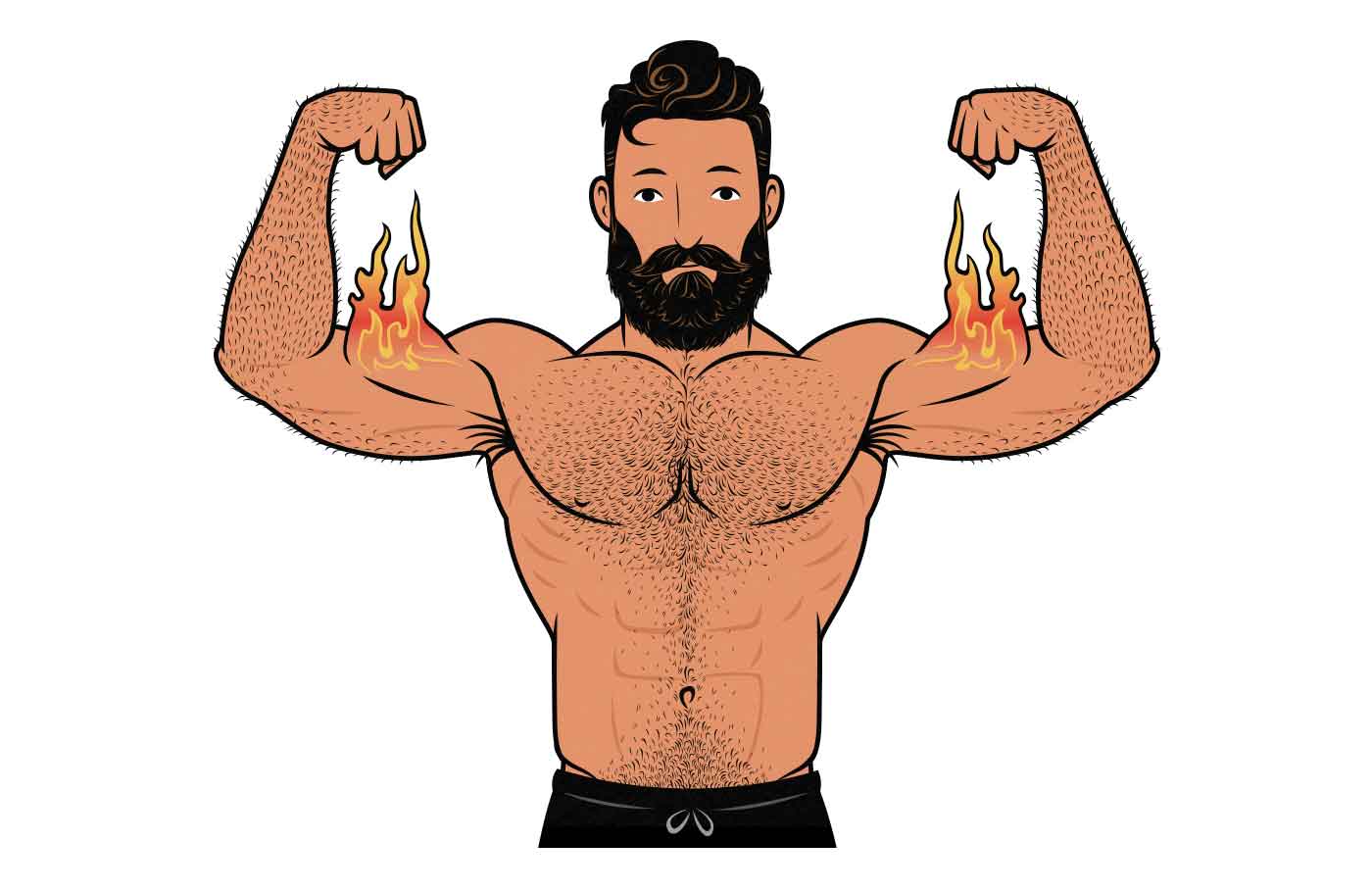
Is Reverse Pyramid Training Good for Building Muscle?
The Research on Reverse Pyramid Training
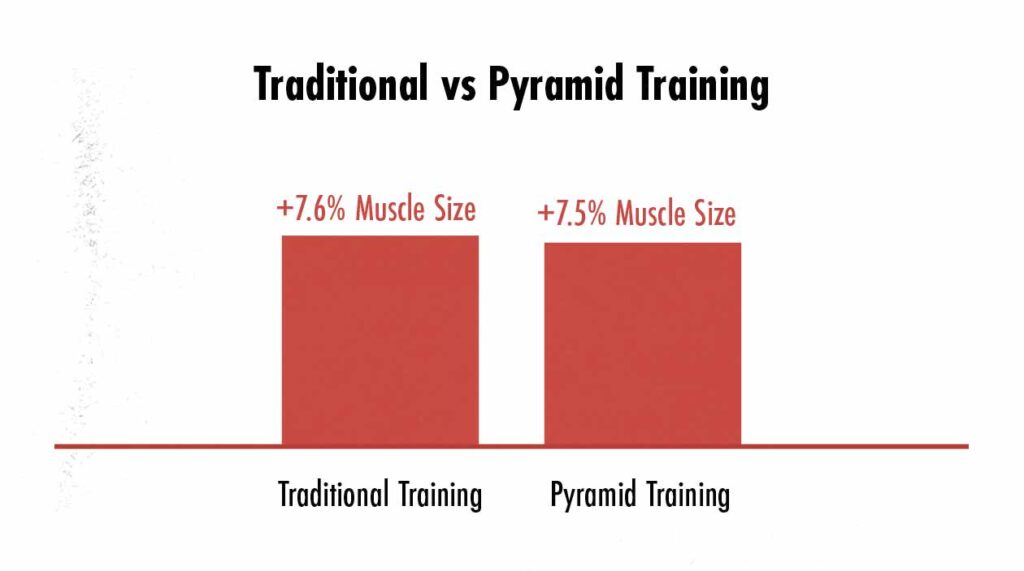
A few studies have compared pyramid training to traditional hypertrophy training.
- The first study found that hypertrophy training stimulated 0.1% more muscle growth. As you can imagine, the difference wasn’t even close to being statistically significant.
- The second study on pyramid training had similar findings. Again, the traditional hypertrophy training group gained more muscle size, again without reaching statistical significance.
- The third study found that using a tight rep range (12, 10, and 8 repetitions) stimulated the same muscle growth as using a wider rep range (15, 10, and 5 repetitions). This suggests that if we’re lifting within the hypertrophy rep range, it doesn’t matter exactly how many reps we do per set, just that we’re training hard enough.
- The fourth study found that doing power training, strength training, and hypertrophy training in the same workout stimulated more muscle growth than splitting those types of training into different phases. This suggests that pyramid training could offer an advantage. Mind you, there weren’t any differences in upper-body muscle growth. Plus, this study is an outlier.
Is There a Benefit to AMRAP Sets?
The other defining feature of pyramid training is that the sets are often taken to failure. Some research shows that when doing fewer sets per exercise, it’s better to push them closer to failure (study). However, as Greg Nuckols discovered, that benefit only seems to apply to novice lifters doing isolation lifts (study, study, study, study). When we look at intermediate lifters doing compound lifts, there appears to be no difference between going to failure and leaving 1–3 reps in reserve (study, study, study, study).
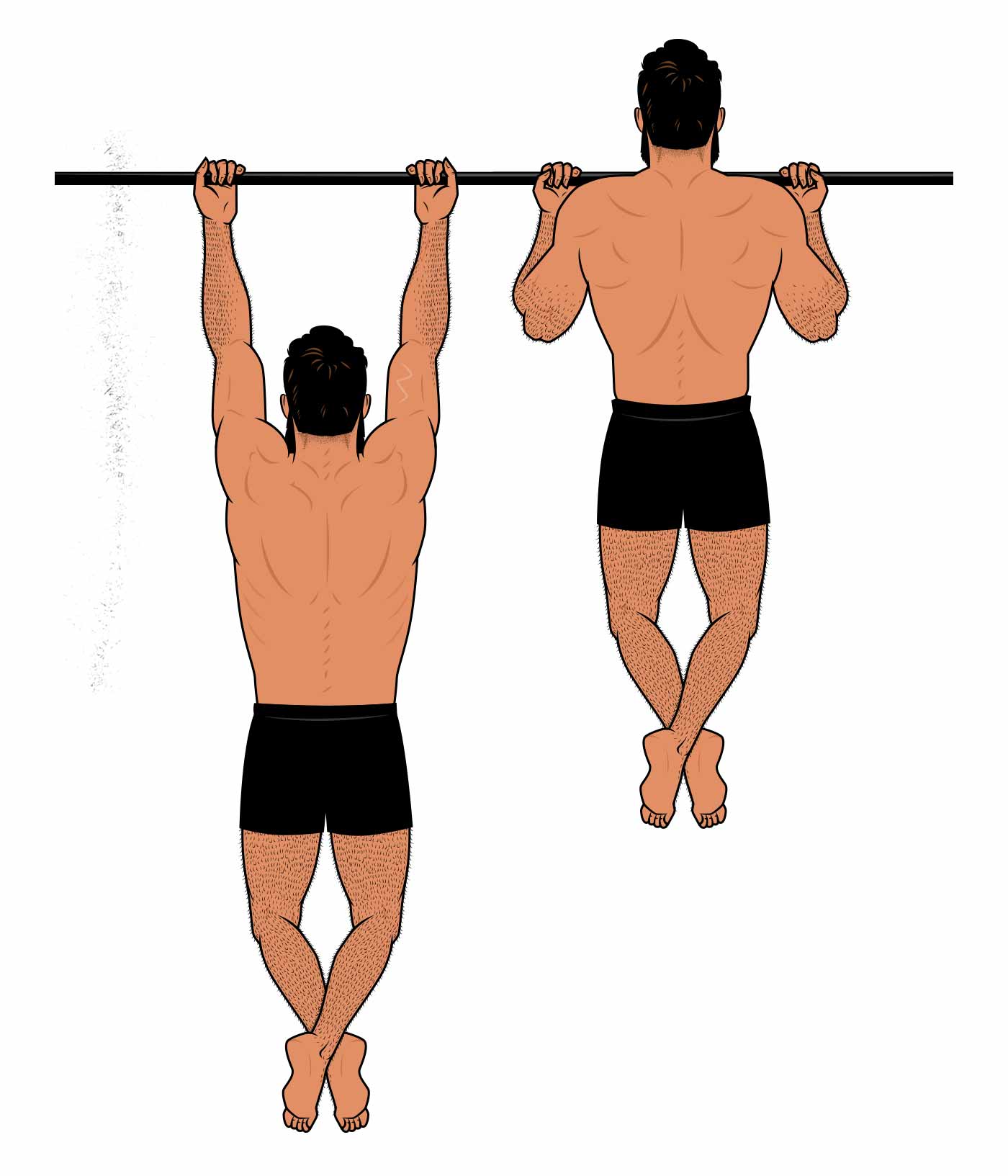
However, some top researchers, including Brad Schoenfeld, PhD, speculate that training to failure stimulates more muscle growth. His recommendation is to leave a couple of reps in reserve during most sets but to take some of our final sets to failure, especially with smaller isolation lifts.
Occasionally going to failure also ensures you aren’t accidentally leaving more than 2–3 reps in reserve, which can severely reduce muscle growth. When an intermediate lifter hits a plateau, it often helps to spend some time practicing lifting to failure (at least on some sets). That’s what we do in our Outlift Program.
Post-Activation Potentiation?
One study found that doing 1–2 easy heavy reps with 90% of 1RM before doing lighter sets increased performance (study). As a result, reverse pyramid training might be better than pyramid training.
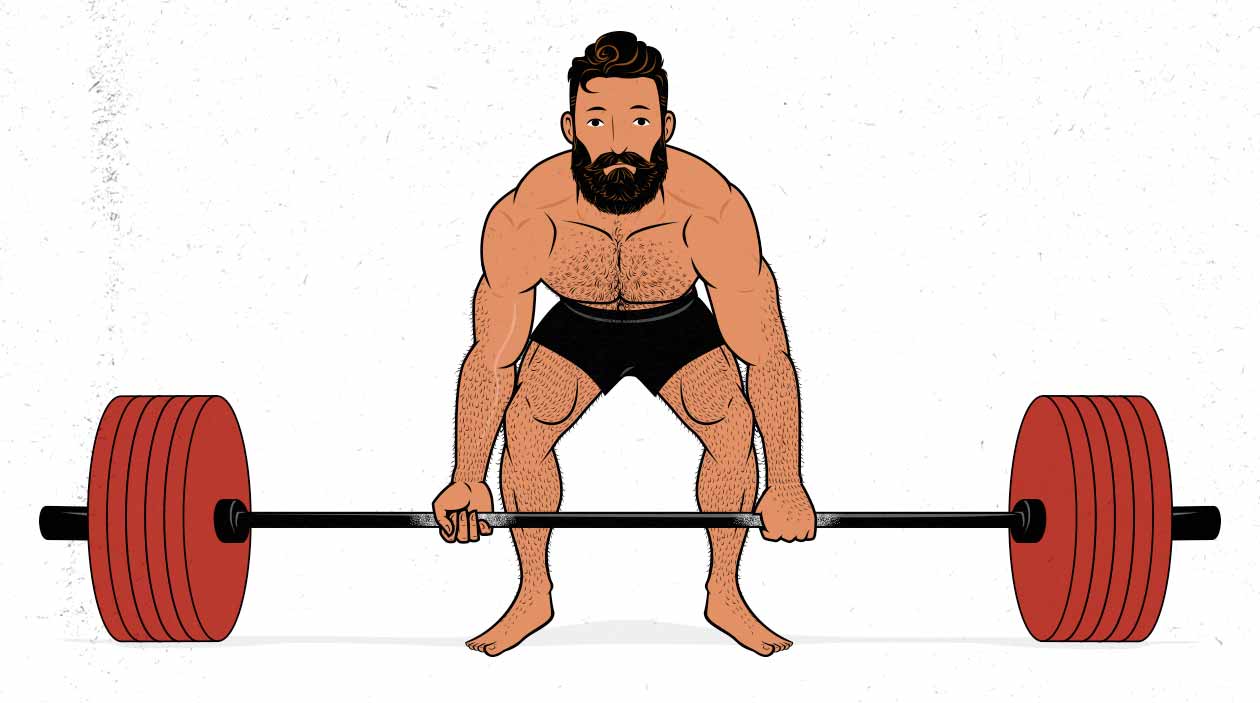
On the other hand, another study found that doing hard heavy sets before lighter ones didn’t improve performance. The conclusion was that unless the post-activation potentiation sets are far from failure, they generate fatigue and thus don’t give a performance benefit to subsequent sets. Since Reverse Pyramid Training has us lifting hard every set, it probably doesn’t offer us an advantage over traditional hypertrophy training.
Reverse Pyramid Training Works
Overall, Pyramid Training seems to stimulate the same amount of muscle growth as traditional hypertrophy training. Doing sets of 8, 10, and 12 repetitions probably stimulates the same amount of muscle growth as doing 3 sets of 10 repetitions.
Sample Reverse Pyramid Training Workout Routine
Any workout routine can use Reverse Pyramid Training, but the most popular way of doing Reverse Pyramid Training is to use a 3-day full-body workout routine with each workout built around two big compound lifts. These workouts are usually designed to be short, intense, and efficient, allowing people to build muscle at full speed without spending as much time training.
Here’s a sample Reverse Pyramid Training routine built around the Big Five Hypertrophy Lifts. As most Reverse Pyramid Training programs are, it’s loosely based on Martin Berkhan’s approach, but we’ve adjusted it a little bit for the goal of gaining muscle size. The training volume is slightly higher, the lifts are slightly different, and we don’t recommend using 0 reps in reserve on every set (as discussed below).
Workout One (Monday)
- Bench Press: 3 sets, starting with 6–8 repetitions, stripping 10% off the barbell, then doing 8–10 repetitions, stripping off another 10%, and then 10–12 repetitions (3×8,10,12)
- Barbell Row*: 3 sets of 8, 10, then 12 repetitions (3×8,10,12)
- Skull crusher: 2 sets of 10 repetitions (2×10)
- Barbell Curl: 2 sets of 10 repetitions (2×10)
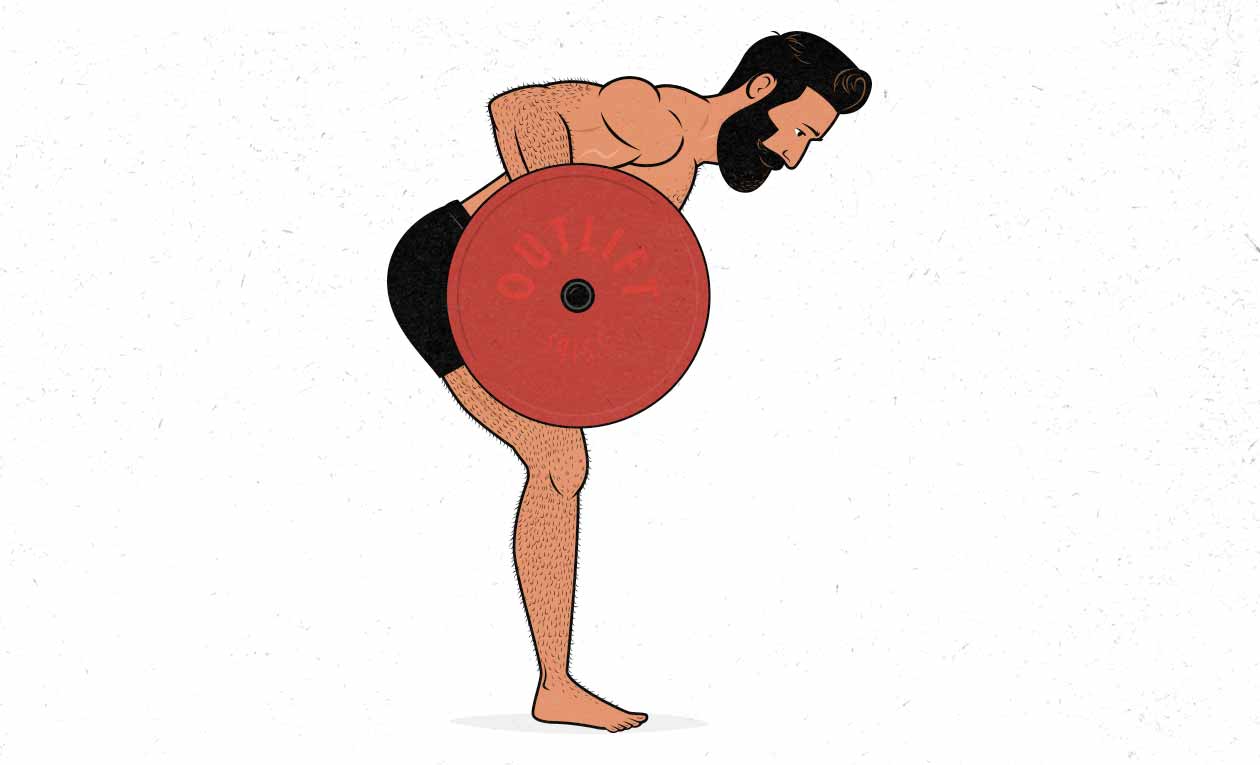
*The barbell row is chosen because it makes a good accessory lift for the deadlift, giving our spinal erectors and hips extra work along with our upper-back muscles. This means we’re training our entire posterior chains twice per week. It’s okay to swap these out for other row variations, such as dumbbell rows or seal rows, but we’d lose that accessory work for the deadlift. That’s why the barbell row is the default. You can, however, choose whichever variation of barbell row you prefer. I prefer the “bodybuilder” variation, as shown above.
Workout Two (Wednesday)
- Front Squat*: 3 x 6, 8 then 10 repetitions (3×6,8,10)
- Chin-Up**: 3 sets of 6, 8, then 10 repetitions (3×6,8,10)
- Hanging Leg Raise: 2 sets of 10 repetitions (2×10)
- Barbell Curl: 2 sets of 10 repetitions (2×10)
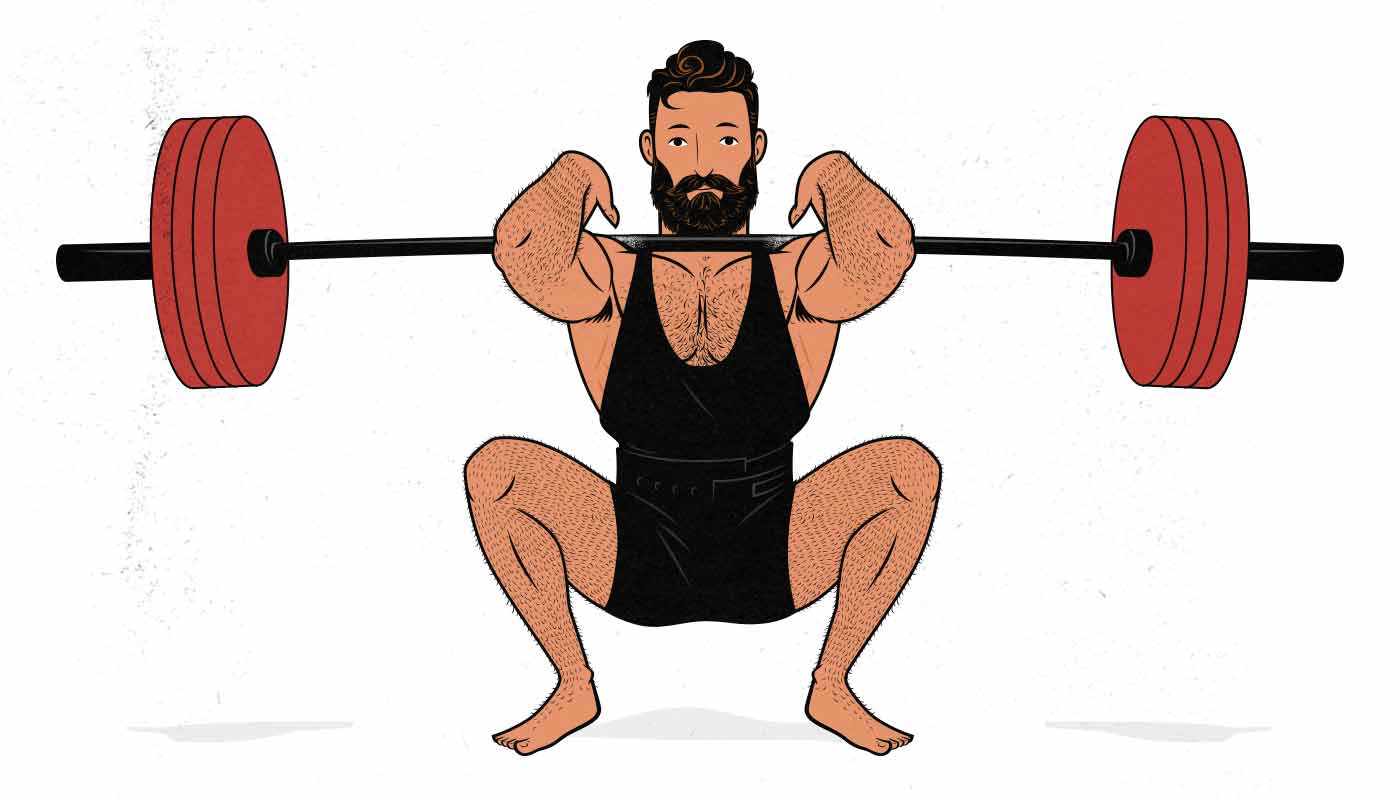
*We chose the front squat over the back squat because it works the knees through a deeper range of motion, is safer and easier to recover from than back squats, and works our spinal erectors, giving it good carryover to our deadlifts and rows.
*We chose the chin-up (underhand) over the pull-up (overhand) because it uses a larger range of motion and engages the biceps.
Workout Three (Friday)
- Conventional Deadlift*: 2 sets of 6 then 8 repetitions (2×6,8)
- Overhead Press: 3 sets of 6, 8 then 10 repetitions (3×6,8,10)
- Lateral Raise: 2 sets of 10 repetitions (2×10)
- Overhead Extension: 2 sets of 10 repetitions (2×10)
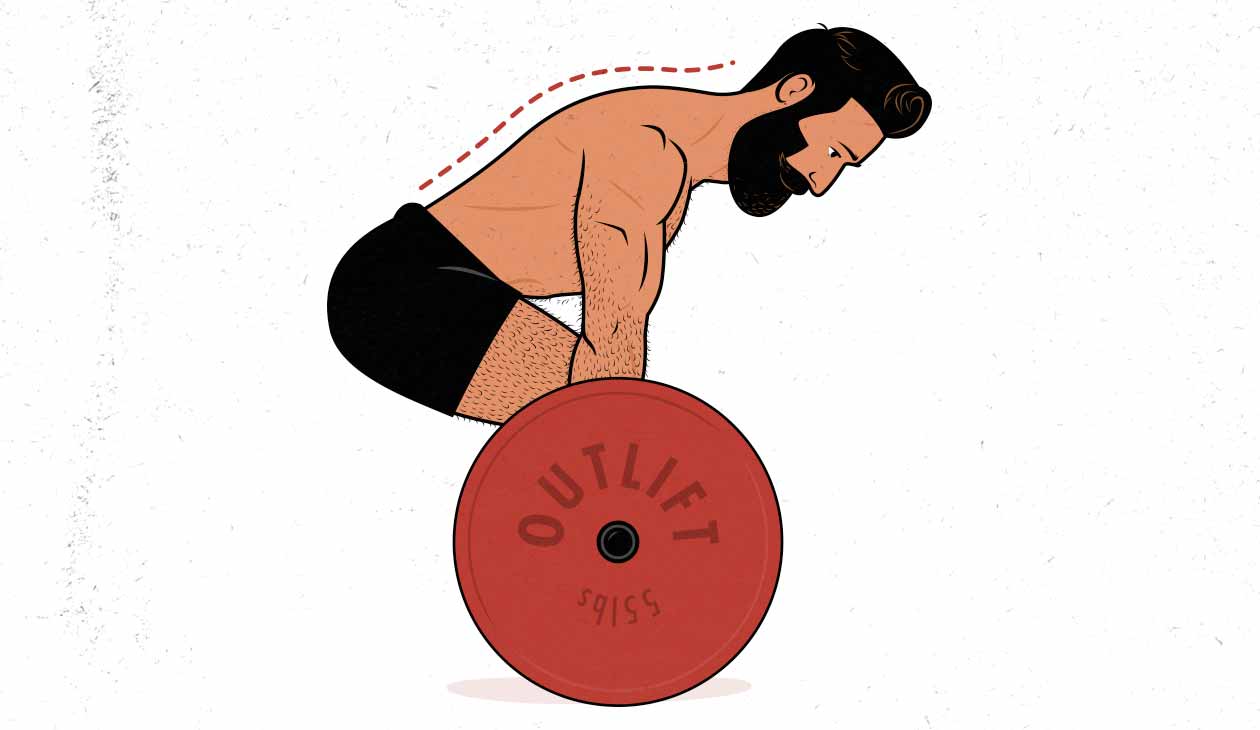
*We chose the conventional deadlift over the sumo and Romanian deadlift because uses a deeper range of motion and works the spinal erectors harder.
Customizing the Workout Routine
This workout routine is just an example. It isn’t set in stone. Feel free to swap out the main lifts for similar variations, such as swapping front squats for high-bar back squats. With the accessory lifts, you have even more freedom. For example, you could swap out biceps curls and triceps extensions for neck curls and extensions to emphasize neck growth or swap them for leg curls and extensions to emphasize leg growth.
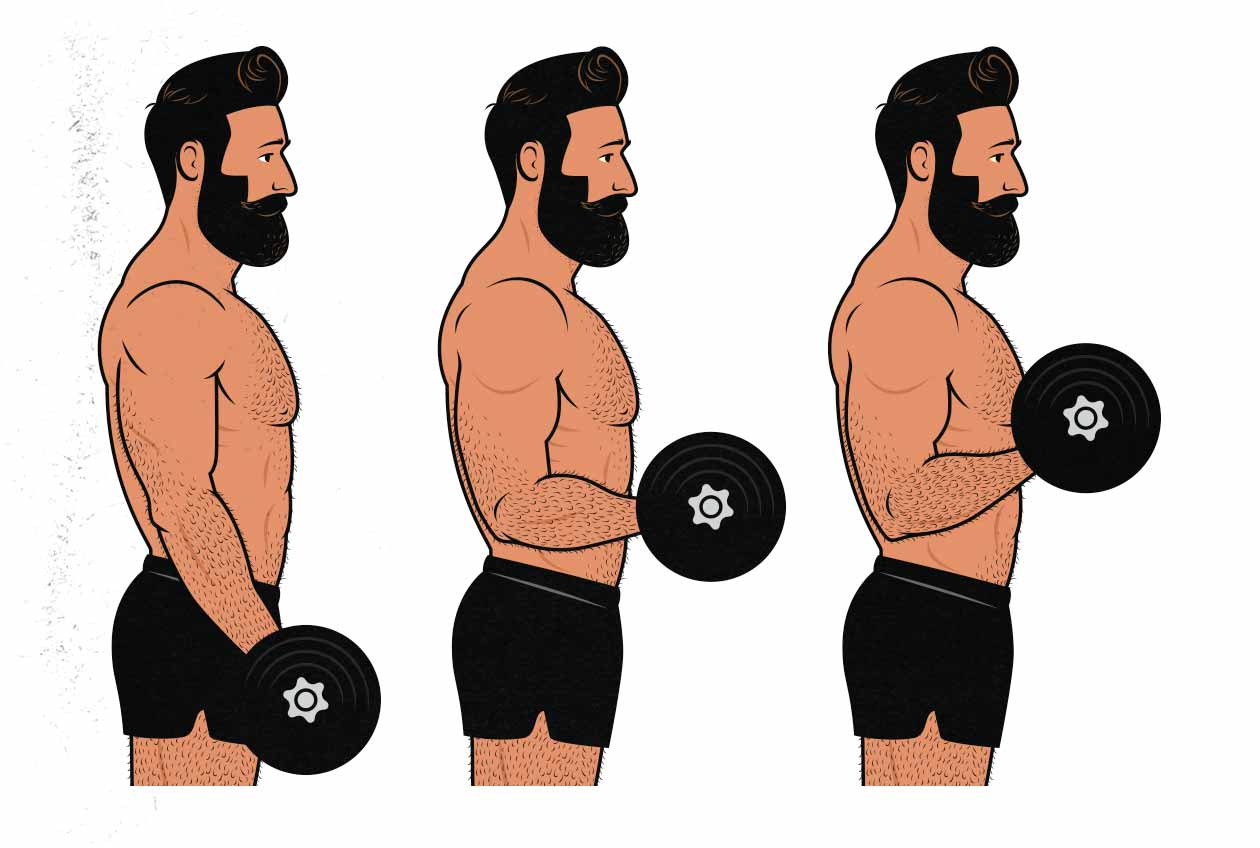
And, as always, listen to your body and adapt accordingly. If your spinal erectors are struggling from all the big lifts, feel free to swap out deadlifts for Romanian deadlifts or barbell rows for dumbbell rows. If your elbows are getting beat up, try doing chin-ups with a neutral grip, barbell curls with dumbbells, or curl-bar curls (with a curl bar or “EZ Bar”).
Reverse Pyramid Training is typically done right to the cusp of failure, with zero reps left in reserve—AMRAP. However, as discussed in the next section, that doesn’t seem ideal for most intermediate lifters, given that it can cause quite a large performance drop between sets. It doesn’t seem to hurt, either, though, especially since this is a fairly low-volume routine where overall recovery shouldn’t be an issue. For optimal results, though, I’d recommend leaving 1–2 reps in reserve on the earlier sets of each exercise, doing as many reps as possible on just the final set of each exercise.
If the workouts feel too short and easy after the first three weeks, add extra sets to your main lifts or an extra accessory lift. If the workouts feel too hard, feel free to remove an accessory lift. But they shouldn’t feel too hard. This is a fairly low-volume routine. If you choose exercises that suit you well, you should be able to handle them.
Frequently Asked Questions
Is Reverse Pyramid Training Better Than Pyramid Training?
Reverse Pyramid Training is better than Pyramid Training. Heavy sets produce better strength gains when we’re fresh, so it’s better to do them first. Moderate-rep sets stimulate just as much muscle growth whether we’re fatigued or not (study), so it’s fine to do them afterwards. Plus, doing heavier sets before lighter sets can make the lighter sets feel easier.
Is Reverse Pyramid Training Good for Bulking?
Yep! You can do Reverse Pyramid Training while bulking. It stimulates just as much muscle growth as traditional hypertrophy training. You can go with your preference.
Is Reverse Pyramid Training Good for Beginners?
We don’t recommend Reverse Pyramid Training to beginners. It complicates training without offering any advantage. If you’re still learning to lift weights, I’d stick with traditional hypertrophy training.
Is Reverse Pyramid Training Good for Weight Loss?
Yes. Reverse Pyramid Training is an efficient way to stimulate muscle growth. It will help you maintain or gain muscle mass while cutting. Plus, it’s efficient, which can be especially helpful if you find that eating less energy leaves you with less energy.
Summary
Overall, Reverse Pyramid Training is an effective way to gain muscle size and strength. It’s not better than traditional hypertrophy training, but it’s not worse, either. Doing a set of 8, 10, then 12 repetitions stimulates the same muscle growth as doing 3 sets of 10 repetitions.

Alright, that’s it for now. If you want more, we have a muscle-building newsletter. If you want a customizable workout program (and full guide), check out our Outlift Intermediate Bulking Program. You get to pick between four different workout programs. Or, if you’re still skinny or skinny-fat, try our Bony to Beastly (men’s) program or Bony to Bombshell (women’s) program.



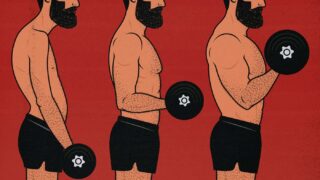

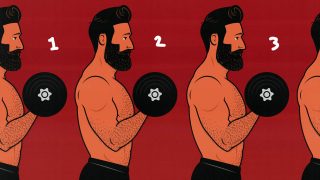
Void report—Greg from Kinobody has made a fortune from advocating RPT and intermittent fasting with slick videos. Turns out it is not that much different after all!
Hey Dave,
I’ve heard that Kinobody’s programs are heavily based on Martin Berkhan’s Reverse Pyramid Training routine and intermittent fasting diet, yeah. Berkhan has accused him of plagiarism, saying that he was a former client who repackaged the coaching advice he got and sold it as a workout and diet program. I have no idea if any of that is true, but I remember those accusations coming out a couple of years ago.
One thing I’ll say is that most programs are largely based on previous programs. And if it isn’t, the likelihood of the program being good isn’t very high. With our own programming, our training method was rooted in what Marco learned while interning under Eric Cressey. We then evolved it over time based on our own experience, new research, and running thousands of clients through it. But it’s not like we sat down and invented it from scratch, you know? And Cressey didn’t do that either. It’s a traditional type of training that’s been slowly evolving over the past few decades. With that said, I’m not sure how much new stuff Kinobody brought to the table or whether it’s enough to make his own approach unique.
I bought Berkhan’s guide before writing this and thought it was great. He’s a smart guy and he’s had a huge influence on the fitness industry. I haven’t seen Kinobody’s programs and can’t really comment on them. I mentioned Berkhan in the article because I think he deserves the credit on this one.
Great article Shane! As always extremely informative and supported by scientific journals. I was actually watching videos on YT about RPT and AMRAP and the detail in this article really cleared up the why for me. Also, I just so happened to read this in reverse (bottom to top) — i’m not sure why lol
Thank you, Mickey! You know, I wasn’t sure whether to put the “how” before the “why” with this one. I just wanted to make sure that people who hadn’t heard of Reverse Pyramid Training knew what it was before talking about whether/why it was effective. Makes sense to read it from bottom to top, too.
What about any warm up sets prior to the 8, 10, 12? How many sets, reps, %max of warm up sets if any at all?
Reverse Pyramid Training doesn’t require a special way of warming up. For instance, for your warm-up sets, you could start off doing 10 reps with a weight you could do 20 reps with, then 5 reps with a weight halfway between that weight and your working weight. And then some people like to do 2–3 warm-up reps with their working weight (or 10% higher) for post-activation potentiation, too. That’s usually enough warming up, but once you get really strong, oftentimes extra warm-up sets are needed.
We should probably write an article on warming up.
This article was surprisingly great. I’ll be honest, after getting bored with the review of Starting Strength article, I didn’t expect much from this. The articles in this review series have all had the same underlying theme of “it’s not bad but it’s not optimal for building muscle”. This was a nice change up.
You even listed a free workout program! Totally blew me away, and I actually really like the looks of the program. Down and dirty and to the point. Very simple, but I could see some guys putting on a lot of muscle with something basic like that. Especially beginners. It reminds me of a simplified version of one of the Outlift programs.
Great article guys, 10/10!
Thank you, Matt 😀
Hi Shane,
I really love your content and the new website. Really well written and informative. I also like the Reverse Pyramid Training routine from the article and can’t wait to put it to use. The only thing I wondered was how good it is for bulking up, since you only hit every lift of the big five once a week. How does this routine compare to a full body workout in which you hit all the main lifts three times a week?
Reverse Pyramid Training done in the Martin Berkhan LeanGains style is designed for cutting and body recomposition. The idea is to use lower-volume training when people aren’t consuming a ton of calories, and thus might have less energy to spend in the gym. The modified routine in this article is slightly higher in volume than LeanGains. You can use it for bulking.
There’s nothing wrong with only doing the Big 5 lift once per week. In fact, extra exercise variety tends to be a good thing at an intermediate level. Just make sure to take care of your target muscle groups with the accessory exercises. This sample routine emphasizes the arms, but you can swap out those curls and extensions for other lifts to suit your goals 🙂
You guys always write incredibly well-researched, thorough, and clear articles—very much appreciated! You really got me back onto front squats after neglecting them for so long.
I wanted to ask about the rep ranges (i.e. 6,8,10 for squats vs. 10,12,14 as I’ve seen Berkhan recommend). I know “hard sets” are the true stimulus for muscle growth, but do you think either matter on a “cut” as long as the volume is less to compensate for less energy during a session?
Do you think RPT is similar in theory to “max rep sets” or other intuitive auto-regulation schemes that compliment cutting? Thanks!
Thank you so much, Dawid!
Anywhere from 4–40 reps per set is good for building muscle. 6–20 reps is slightly better. So whether you’re doing 6,8,10 or 10,12,14, you’re in the middle of the hypertrophy rep range either way. For bigger lifts like squats and deadlifts, I prefer the lower end of that rep range (6–10). For most lifts, I prefer the middle (8–15 reps). And for some lifts, like barbell rows, I prefer the top (15–20). But that’s up to you, and a variety tends to be best 🙂
RPT is a low-volume way of training. It’s not overly difficult or unpleasant. And for that reason, it tends to work really well during cuts. Not because it’s better, but because it’s enjoyable and easy to manage.
Great article! Just have a question. I have been using this approach but with 4-6 sets instead of just 3. I use 90% 1rm all the way to 40%. Is this as effective? I make sure the intensity goes up each week through progressive overload. I just like to hit the exercise EX: (Front squat, Bench, Overhead press) with different loads. My first hard set is anywhere from 3-5 reps, and my last set is anywhere from 15-25 reps. The mid between sets 6-15. Would appreciate a response, Thanks!
Yeah, that sounds great. Depending on the person, those fourth, fifth, and sixth sets might be deep into the point of diminishing returns, but it varies, and it sounds like you’re making progress, so that’s perfect 🙂
[…] programs at all. For example, they may try to bulk with a strength training program, such as StrongLifts 5×5. I don’t have anything against StrongLifts, but at its heart, it’s a strength program, […]